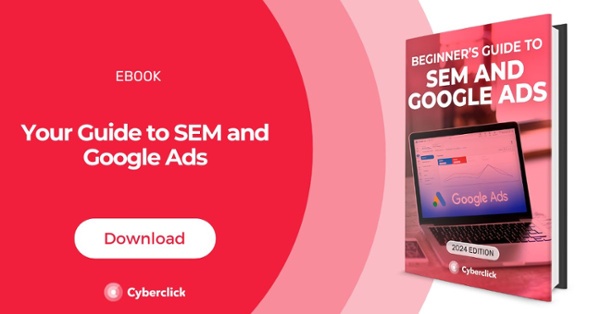- Home
- Cyberclick Academy
- SEM
- SEM Marketing
How to Create a SEM Marketing Strategy for Your Company Step by Step
SEM Content
- What Is SEM? Definition, Advantages, Disadvantages, and Key Concepts
- SEO and SEM: Definition, Differences, and Combined Use
- SEM Positioning: Definition, Characteristics, and Advantages
- What Is a SEM Campaign? Definition, Advantages, and Examples
- What Is Search Engine Marketing? Definition and Basic Concepts
- How to Create a SEM Marketing Strategy for Your Company Step by Step
- How to Set Up and Optimize SEM Campaigns on Google Ads and Their Benefits
Index
Search engine positioning (SEM and SEO) is a key strategy to gain visibility and attract traffic to your brand's website.
However, there can be some confusion surrounding the term SEM marketing. There's debate whether it includes payment ("pay per click" type ads) or covers the techniques designed to improve the positioning of a website on the search engines.
In reality, organic positioning (SEO) and search engine marketing (SEM) are complementary tools. Their combined use will help you in your online marketing strategy. Let's take a look at the advantages of combining them and how you can implement a strategy that incorporates both.
What Is SEM?
SEM, or search engine marketing, is a digital marketing strategy. Its purpose is to increase the visibility (and therefore profitability) of a website in search engine results pages. SEM refers specifically to the paid search advertising that helps achieve this.
SEM is also sometimes called "paid search" or pay-per-click, which can be abbreviated as PPC.
Key Elements of SEM Marketing: SEO and SEM
Under a broad definition, SEM marketing can divide it into two parts. As mentioned, SEO (search engine optimization) is the organic positioning method in search engines. SEO encompasses a series of tools, techniques, and strategies aimed at driving a website to the top positions of Google without having to pay for advertisements.
Within SEO we distinguish two aspects:
- SEO optimizes different aspects of a website from the content and descriptions of the images to the code and more.
- SEO aims to increase the relevance of a page for search engines by getting inbound links from other websites.
SEM places paid ads on Google and other search engines. These ads are at the top of the results and the advertiser is charged every time a user clicks on them. The cost associated is known as PPC (pay-per-click).
The two areas of SEM marketing are useful when it comes to positioning in search engines, but there are some important differences between them.
- They demand a different type of investment. With SEM, you pay every time a user clicks on the ads, so it is a continuous and linear expense. With SEO, you invest time and resources with the goal of obtaining a long-term result.
- The two aim to occupy different places within the search engine results page. The advertisements are located at the top of the page, while the organic results occupy the main area in the center of each results page.
- They correspond to different parts of the conversion funnel. In general, the pages you seek to position through SEO have more informative content and seek to capture users in the early stages of interest. In contrast, SEM focuses more on positioning landing pages. It seeks a more immediate conversion since it targets users who are ready to buy.
The Benefits of Combining SEO and SEM in Your Marketing Strategy
- They are symbiotic. If you invest part of your marketing budget in paid advertising, you will get more people to your website. Also more users will share your content on their social networks and other sites, which in the long run will have a positive impact on SEO.
- It helps multiply the clicks. According to data from Google, having an ad and an organic result in the top spot at the same time generates 50% more clicks (including visits and potential conversions) than if you were positioned only in an organic way.
- It helps you reach customers at different stages of the conversion funnel. With SEO, you can capture users who are beginning to look for solutions to their need. Later, when these same users are searching with the intent to purchase, they may find a paid ad. In this way, the two areas of SEM marketing do not hinder one another but complement each other.
- It allows you to optimize your efforts. For example, if you have done keyword research, you can use what you have learned in both SEM and SEO campaigns.
- They multiply your online visibility. Even if people don't click, seeing your brand twice when doing an online search increases the user's memory of your brand and associates it with what they need.
How to Create a Combined SEM Strategy Step by Step
As mentioned above, combining SEO and SEM is a strategy that helps you get the most out of your digital marketing. Now let's see how to put this into practice.
1. Research Your Keywords
Keywords are the essential pillar in any SEM strategy. To carry out a complete study, follow this method.
- Analyze the current situation of your website and the sites of your competition. What words are you positioning for?
- Define your the buyer person(s). Focus on what their needs are and how they seek to resolve them through online searches.
- Search for generic keywords and brainstorm. You can utilize tools such as Google keyword planner, Ubersuggest, Moz or SEMRush to do this.
- Search for "long tail" keywords which are more specific. Continue to the keyword tools mentioned above to find terms that respond to a very specific need that your brand can address.
- Organize and classify your list of keywords. Finally, you must analyze the list of keywords you have generated and implement the ones that are most relevant to your brand, have a higher number of searches, and generate less competition.
2. Create Your SEM Campaigns
Given their potential to generate immediate results, you should start by creating SEM campaigns and leave other aspects of SEM marketing for the next step.
In this step, define the campaigns, ad groups, keywords, and creatives. You will use them in Google Ads, Bing Ads or other search engines and put everything in motion.
3. Take Advantage of the Work Done for SEO
Once you have your SEM marketing campaigns running, it's time to start working on the organic positioning of your website. For this, you will need to rely on the keyword research that we have previously done. You can also use the first results of your ads to get an idea of which topics attract more interest from your audience.
This information will help you create well-targeted content that responds to the needs and searches of people online. This will help you gain positions in search results. You should also implement off page SEO like link building, a very important SEM technique to improve your authority and positioning.
SEM has great potential to help companies achieve their goals quickly and is scalable. However, for your campaigns to be successful, it's ideal to have experts who have extensive experience positioning brands on Google. If you want to take advantage of all the benefits of SEM marketing for your brand, get in touch with us!
Recursos para seguir aprendiendo: ebooks, vídeos y cursos

Cyberclick

Cyberclick

Cyberclick

Cyberclick

Cyberclick



